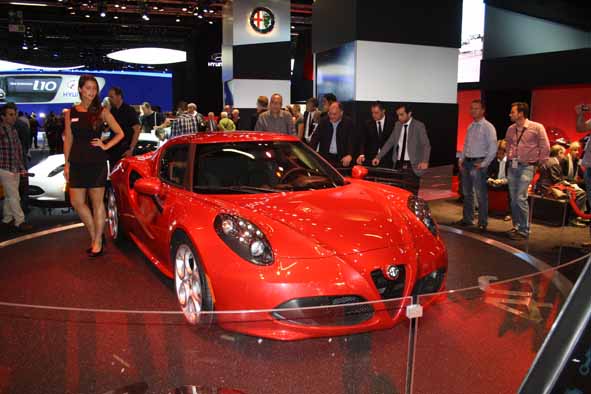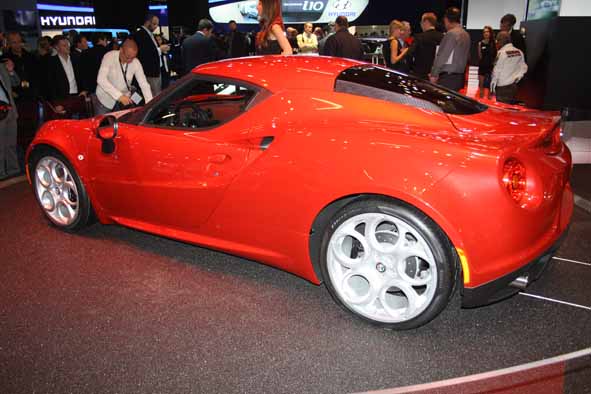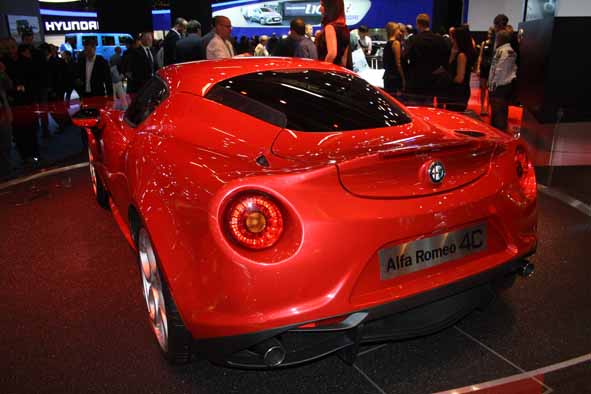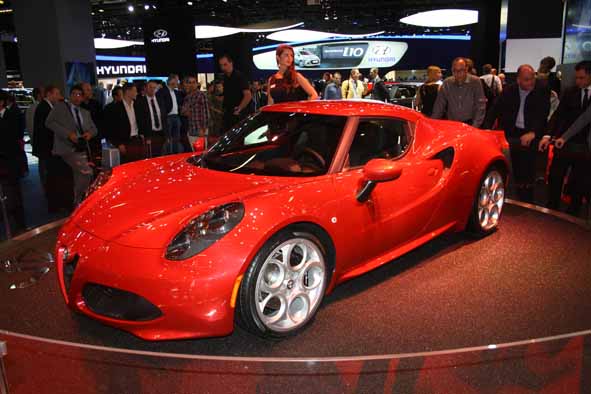Frankfurt Motorshow - Alfa Romeo 4C: excellence made in Italy

Alfa Romeo unveils the technical contents and manufacturing secrets of the new 'compact supercar' which embodies the sportiness intrinsic to the 'Alfa Romeo DNA': performance and engineering excellence offering maximum driving satisfaction in total safety in addition to breathtaking style.
The Alfa Romeo 4C developers have combined the best technical and manufacturing competencies of two brands: Alfa Romeo and Maserati. Thanks to the internal synergies of the Fiat - Chrysler Group, the two carmakers were able to collaborate from the perspective of integrating Alfa Romeo's design roles and Maserati's manufacturing functions. The engineering and technological contribution of other Italian world-wide leaders in the component industry for high-performance sportscars has also been instrumental in achieving the result.


In particular, the Maserati plant brings in topmost quality and meticulously studied details reminiscent of hand-crafted work. As the birthplace of the world's most famous 'sportscars,' Modena and its surroundings are definitely the place that offers everything one may need to manufacture them: tradition, technology and know-how, but most of all, the same passion driving the team who conceived, designed and built the Alfa Romeo 4C.
Hi-tech materials for weight/power ratio for the supercar
Contents and performance become an achievable dream.
The most advanced mix of hi-tech materials combines exceptional stiffness and strength with a reduced specific weight.
Weight/power ratio lower than 4 kg/HP and total dry weight of just 895 kg.
The carbon fibre monocoque weighs just 65 kg.

The Alfa Romeo 4C was born from a clean slate and an idea or, rather, the clean state was the prerequisite for conceiving, developing and producing a new concept in the domain of sportscars, the "affordable supercar." The 4C was designed not only to be an exclusive car both for contents and performance, but also to become an achievable dream for Alfa Romeo fans all over the world. As a consequence, it was necessary to think in terms of limited production volumes, but still in the order of some thousands vehicles per year and, therefore, decidedly higher than those of the practically handcrafted production characterising this class.
The clean slate, which was initially free of design and manufacturing constraints, was soon assigned new parameters and presented with new challenges the first of which was a fundamental reference data point: a supercar weight/power ratio must be less than 4 kg/HP.
To achieve the right ratio, Alfa Romeo designers could have focused on horsepower (i.e.: increasing power and performance), but this would have impacted the purchase and maintenance costs, thus making the car significantly less affordable. They decided to go a different way; they reduced the car weight by using materials where lightness is combined with efficiency and by perfecting, sometimes even creating, manufacturing processes where high technology is joined to craftsmanship. In this way they were able to obtain a total dry weight of just 895 kg, a true record that makes the 4C one of the lightest cars in the world. The 4C is lighter than a city car and its weight/power ratio is less than 4 kg/HP.
In order to achieve this ambitious goal a lot of attention was devoted to the materials, each of which was chosen on the basis of its specific weight as well as on the chemical-physical, mechanical and technological properties that best fulfil the performance requirements and dynamic behaviour needs of a sports car. The 895 kg of vehicle weight mainly consist of aluminium, steel, lightened SMC and carbon fibre.
Carbon fibre
The secret of the 4C Alfa Romeo lightness and dynamic behaviour lays in the use of 10% carbon fibre, which represents 25% of the 4C overall volume. At present, carbon fibre is the material offering the best weight/stiffness efficiency. This is the reason why it was chosen for the structural function monocoque that makes up the central, load-bearing cell of the chassis. This solution combines reduced weight and excellent performance, and is already adopted for the most advanced supercargo; the monocoque weighs just 65 kg.
The monocoque was entirely designed by the Alfa Romeo specialised team and manufactured by Adler Plastic by means of an innovative manufacturing process capable of joining state-of-the-art manufacturing technology and the manual craftsmanship typical of the Italian artisans. Thanks to this approach, the 'pre-preg' technology inspired by the Formula 1 was also transferred to standard manufacturing, so much so that Alfa Romeo is the only brand capable to assure a production of over 1,000 pieces per year.
'Pre-preg' carbon fibre processed in an autoclave with vacuum bag marked the passage from piece design to material design. The monocoque has reached stress and dynamic behaviour response levels that would be unthinkable with different technologies and materials.
'Pre-preg' carbon fibres may be arranged in an optimum structural direction in relation to the forces, thus producing a result that metal would only yield if layers were overlaid, shims differentiated, and reinforcements added.
In addition, the autoclave polymerisation makes it possible to manufacture box-section structures in one phase, whereas normally the production and assembly of various components often made of different materials is required. One example would be the door post. In its standard steel version, the door pillar is comprised of approximately 6 pieces assembled to one another and to the car body at different stages of the manufacturing process.
If autoclave polymerisation is used, the door post is a one-piece component included in the load-bearing structure.
The monocoque is a carbon fibre one-piece structure and, as such, it resists external stress with a clear advantage in terms of dynamic behaviour.
Aluminium
The choice of materials characterised by high torsional rigidity and reduced specific weight is a common element to all of the 4C structural parts. An example in this sense is the use of aluminium for the roof reinforcement cage and the front and rear frameworks. Just as in the previous case, some interventions aimed at reducing the weight and increasing the stiffness of the component were made in the component design and manufacturing phases. In particular, the designers replaced the traditional rectangular strut section with a newly designed section. In this way, they obtained lighter and, at the same time, safer frameworks. Frameworks are manufactured using the innovative 'Cobapress' process. Cobapress joins the advantages of fusion and the benefits of forging under press by compressing the aluminium alloy even further, thus removing any residual porosity. All this determines the component lightening to the advantage of its mechanical properties.
In addition, thanks to the use of seam welding processes, the welding is very precise, the components are not deformed and the filling of the gaps is excellent.
Aluminium also plays the main role in the hybrid-type front brake discs with aluminium bell and cast iron ring gear. This patented technology developed by SHW guarantees up to 2 kg of weight reduction per disc in addition to better braking. Furthermore, the sophisticated surface finishing technology by brushing increases grip and pedal feeling whereas the innovative release system between disc and bell guarantees a more comfortable and safer braking. The difference in the thermal expansion coefficients of cast iron and aluminium is compensated by specific steel radial pins that accurately transmit the braking action.
SMC (Sheet Moulding Compound)
Using SMC (Sheet Moulding Compound), a low-density and high resistance composite material, for the body has allowed a 20% weight reduction in comparison with the traditional sheet steel. The Alfa Romeo 4C is the first standard production car to achieve such a high percentage of low-density SMC: with a weight of 1.5 g/cm³ this material is decidedly lighter than steel (~7.8 g/cm³) and aluminium (~2.7 g/cm³), besides being more malleable. This feature has allowed for the styling and design freedom that were necessary to create a true, instantly recognisable Alfa Romeo. Moreover SMC is a stable material which, unlike aluminium, does not strain in the event of minor impacts, has high resistance to chemicals and atmospheric agents, and also disperses noise very well to the advantage of acoustic comfort.
Finally, low-density SMC guarantees a good functional integration of the parts; this in turn entails a reduction in the number of components and operations, and requires shorter assembly times, thus lowering production costs.
PUR-RIM (injected polyurethane)
The PUR-RIM (injected polyurethane) was chosen for bumpers and wings for the same reasons described above. It is a lightweight material (it weighs 20% less than steel) suitable for creating very complex design elements, such as the 4C wing, and for keeping an ideal cost/production volume ratio.
Windows
In the search for the lowest possible weight, no material was ignored, not even glass. In the case of glass, the lightening was obtained by adopting a real silhouette-thinning approach: all the window glasses are on average around 10% thinner than those normally fitted on cars; this allows for an average weight reduction of 15%. The windscreen in particular is only 4 mm thick. This is an extraordinary result especially in consideration of the fact that this particularly aerodynamic shape is difficult to obtain on such thin glass.
June 11, 2013
Maserati plant in Modena: home of the new Alfa Romeo supercar
Since the 1930s, the Maserati workshop has produced several genuine automotive engineering "masterpieces," on-road cars and racing cars that have become legendary.
The minimum 'takt time' is 20 minutes vs. the 50 seconds of "mass production facilities."
4C Alfa Romeo works are built.
The supercar production takes place in dedicated areas for 'body fitting' and 'assembly' operations, whereas the 'testing' and 'finishing' areas are shared with the Maserati production.
Measuring room: up to over 400 measurement points for checking the body quality.
Every 4C produced is road-tested for 40 km by an experienced test-driver.
Towards the end of the 1930s, all Maserati manufacturing activities were transferred to the plant located in Viale Ciro Menotti in the city of Modena and over the last 70 years the facility has produced several genuine automotive engineering "masterpieces," on-road cars and racing cars that have become legendary.
In the last decade only, these assembly lines have produced several technical and style 'jewels,' such as: Quattroporte, Granturismo and Grancabrio. More recently, with the fascinating Alfa Romeo 8C, the Maserati plant has opened its doors for the first time to another brand with similar tradition and ambition.
Seen its historical and recent background, Modena was the natural choice for the Fiat Group when it came to mass-producing the Alfa Romeo 4C, a vehicle that combines highest technology and the sort of meticulous details that can only be provided by human attention. This manufacturing philosophy is an integral part of the Maserati DNA in the Modena plant.
In this plant, innovation combines first of all with people's passion, which then translates into discipline and determination to succeed. The operator's touch adds value to the product, so much so that this plant's operating modes deviate from the "mass production" logics in favour of a decidedly more handicraft dimension. Suffice it to think that the minimum 'takt time' (the manufacturing speed needed to guarantee delivery) is of 20 minutes: this is an indicator of the plant distinctiveness as opposed to the "mass production plants" in which the shortest 'tackt time' is approximately of 50 seconds.
The fundamental role played by human talent in a heritage made up of technical competence and master craftsmanship is now evident. All of them are experienced operators, young women and men whose age averages approx. 29. 60% of them holds either a high-school diploma or a university degree and has on average over 5 years of work experience on Maserati models. They are truly a chosen group of manufacturing professionals capable of performing knowledgeable work on up to 40 different stations and of carrying out activities lasting from 20 to 40 minutes: in other words, they are highly skilled mechanics capable of mastering the production workflow practically from start to end.
The Alfa Romego Supercar production takes place in dedicated 4C workshops, that is areas for 'body fitting' and 'assembly' operations, whereas the 'testing' and 'finishing' areas are shared with the Maserati production.
"Body fitting" area
The 4C primary structure is assembled in this area: here the first "skins" are applied to the newly created "body in white". In particular, station no. 10 operators fit the carbon monocoque on the front and rear chassis and on the crossmembers. This manual operation requires a continuous conformity check of those parameters, like the tightening "angle torque," which guarantee the permanent union of the connected elements in all operating conditions, even the most demanding.
A little further down the line, on station no. 30, the vehicle cell is closed using the windscreen frame and the roof: this operation requires the use of special masks that allow to obtain the exact passenger compartment geometry. Finally, couplings are produced with state-of-the-art polymers and reinforced with mechanical joints.
Measuring room
Once the body is fitted, the 4C "body in white" undergoes a quality assurance check in the measuring room. Every day several sample bodies are subjected to high precision measurements. The dedicated team checks up to over 400 measurement points in order to ascertain that the body is perfect from a geometric and dimensional standpoint. In this process, there is no room for tolerance: the measurement results must comply with the blueprint.
Painting and assembly
The next step is painting, this is the only process performed outside the Maserati plant. After they have been painted, the "bodies in white" return to the plant to "be distributed" on the Alfa Romeo 4C. It is important to note that the new compact supercar is the only vehicle starting its assembly sequence with a "disassembly" operation. Before the internal components can be assembled on station no 1, the car is brought back to its primary structure by removing some of the parts that have already been painted, such as the bonnet and the doors, and some structural parts, such as the rear frameworks and the turret bar. At this point, the car is attached to the rotating hook.
In this area, the operator's mastery is the heart of the whole process. This is the reason why the working station and the whole logistics are built and structured around the operator. All the components needed for manufacturing the 4C are delivered to the various stations in the exact amount, at the precise location and at the right moment. For instance, in station no 2, no unnecessary or unnatural movements are required: the vehicle lifts or turns in such a way as to always position the operation side at the right height. This is conducive to quality and allows the operators to better apply their manual skills.
Some operations, like the window installation, are performed by robots elsewhere. In the Modena plants they are entrusted to the operators' attention: this is another exclusive trait of the 4C manufacturing process. That is not all. Many of the vehicle subassemblies, for instance headlights and dashboard, are assembled at the plant, as opposed to what happens in other industrial sites where they are preassembled by the supplier. All these aspects deeply influence the perceived and effective quality of the end product.
Testing area, road test and finishing
Testing is the only phase in the manufacturing process that relies on technology as an objective means to assess performance quality. Every detail of the vehicle is strictly checked by the systems: from the climate control system correct operation to the mechanical component settings and the dynamic behaviour.
Every 4C produced is road-tested for 40 km by an experienced test-driver. This is another practice that is commonly used for the most prestigious supercars. It is worth underlying that our team of test drivers is one of our plant jewels: all the pilots are experts in their field, they are sporty-drive and car-racing enthusiasts besides being outstanding professionals.
At this point, the 4C manufacturing cycle is almost complete: the cars reach the Finishing area where they are subjected to the final setup operations before being sent to Commercial Logistics, headed towards the market.
4C: bridging Alfa Romeo brand's past and future
Designed by Alfa Romeo's Centro Stile, the 4C model immediately brings to mind some iconic classic models that have left an important mark in the brand's history. Today they all relive in the new compact supercar: "The Alfa of Alfas."
The new Alfa Romeo 4C will be available for purchase in 2013, marking the return of the Italian brand to the United States and inaugurating Alfa Romeo's global growth plan.
The Alfa Romeo 4C is inspired by the century-old tradition of Alfa Romeo and projects the brand's authentic values into the future: Italian style, performance and engineering excellence offering maximum driving satisfaction in total safety. Indeed, the designation '4C' refers to Alfa Romeo's great sporting tradition: in the 1930s and 1940s the names 8C and 6C were used for cars - both racing and non - fitted with the powerful 'eight cylinders' and the innovative 'six cylinders'. The 4C design layout and construction confirms the goal of achieving the weight/power ratio of an authentic supercar (lower than 4 kg/HP) but by containing the weight rather than by increasing the maximum power supplied by the engine in order to guarantee maximum agility and optimum performance.
Designed by Alfa Romeo engineers and manufactured at the Maserati plant in Modena, the captivating coupé with two bucket seats uses technologies and materials derived from the 8C Competizione - carbon, aluminium, rear-wheel drive - and technologies from the latest Alfa Romeo standard models currently on the market, but thoroughly developed to enhance the sports appeal of the new car to the full. This is demonstrated by the new 1750 Turbo Petrol engine with direct injection and aluminium block, the sophisticated "Alfa TCT" twin dry clutch transmission and the Alfa DNA selector with the brand-new Race mode.
A length of approximately 4 metres and a wheelbase of less than 2.4 metres: on the one hand these dimensions emphasise the car's compact features while accentuating its agility on the other. In addition, the excellent dynamic qualities of Alfa Romeo 4C are reinforced by a weight to power ratio of less than 4 kg/HP; it's a value worthy of a real 'supercar.' This vehicle quite simply screams Alfa. Its sports car soul creates a unique driving sensation, both on the road and when racing, where its speed and transverse acceleration become even more demanding.
The 'Alfa of Alfas'
Designed by Alfa Romeo's Centro Stile, the 4C model immediately brings to mind some iconic classic models that have left an important mark in the brand's history. Today they all relive in the new compact supercar: "The Alfa of Alfas."
One of the reference models in terms of dimensional and layout similarities is definitely the 1967 33 Stradale, a very elegant vehicle with vertical-opening doors possibly the most beautiful coupé of all times. This vehicle blended extreme mechanical and functional needs with an essential style, adequately interpreting engine and chassis with unmistakably Alfa Romeo treatments.
That same quest for the essential has also been used to design one of the lightest cars in the world; a true 'race against weight' that led to the right mix of 'lightness and efficiency' through exploring new solutions and materials and meticulously developing state-of-the-art technologies inspired by Formula 1 or aeronautics.
This same combination of "lightness and efficiency" was also at the basis of some unforgettable Alfa Romeos developed in the past, like the 1938 8C 2900 B Touring with its aluminium body, a memorable Le Mans protagonist or like the 1952 1900 C52 "Flying Saucer," a car that could reach 230 km/h and weighed just 760 kg.
With the captivating 4C, the Alfa Romeo brand also proposes its view on 'Technology' just as it did with the 2010 Giulietta, the first vehicle ever to develop and adopt the TCT transmission ; and its interpretation of 'Dynamism,' as it did in the 2007 8C Competizione, the fastest road car ever manufactured by Alfa Romeo, produced in a limited series of only 500 vehicles.
Today the values of lightness, efficiency, Italian style, technology and dynamism are blended in the new Alfa Romeo 4C, a genuine but affordable sports car, a technologically advanced and captivating supercar offering precision, agility and performance. In short, a car worth driving, enjoyable on the road and on the racing tracks just like any Alfa Romeo car should be: this is also a distinguishing trait of this historical brand that continues to be one of the most famous and appreciated ambassadors of the Made in Italy worldwide.
A product emblematic of a global brand facing the heart of the Premium market
In Europe the first Alfa Romeo 4C are scheduled to be delivered in the second half of September 2013 whereas the US version will be launched in November 2013 in Los Angeles, while the first deliveries are scheduled for the end of 2013. The 4C will be available concurrently in the Northamerican market and in all the main markets worldwide. The corresponding price will be announced at the moment of the launch in each market and will take the competitive landscape into account. The annual overall availability is limited to 3,500 cars, 1,000 of which are destined to the European markets due to constraints bound to the technical and technological solutions adopted.
The 4C marks the initial point of the Alfa Romeo global growth plan. Also in view of future models, the carmaker presents itself as a global brand and a competitor at the heart of the Premium market. This is why synergies are being put into place with the Fiat-Chrysler Group Premium brands, in particular with Maserati to which Alfa Romeo brings the power of its heritage, innovation ability and world-wide reputation. In this sense, therefore, the 4C supercar is an emblematic product with a very high qualitative level and an amazingly refined technology embodying the Alfa Romeo brand's deepest values.
















 History of "Menu dei Motori"
History of "Menu dei Motori"

 DESIGN PROJECT
DESIGN PROJECT UNIVERSITA' DI MODENA
UNIVERSITA' DI MODENA








Comments
Nessun commento presente
Add Comment